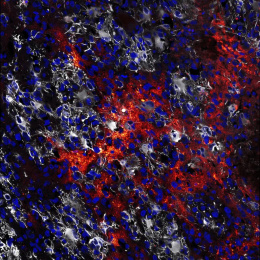Human Endometrial Cells Grown on a 10,000 Well Plate, Version #1
Human Endometrial Cells Grown on a 10,000 Well Plate, Version #1
Submitted by Grinia Nogueira and Michael Beste of the Hammond and Griffith Labs at the Koch Institute
Koch Institute at MIT, MIT Department of Chemical Engineering, MIT Department of Biological Engineering
Grinia Nogueira and Michael Beste
Hammond and Griffith Labs, Koch Institute
Laser-Scanning Micrograph of Microwell Array
"Like metastatic cancer, numerous pathologies arise from rare progenitor cell populations that seed new lesions at sites distant from the tissue of origin. In endometriosis, displaced tissue progenitors are thought to give rise to invasive endometrial implants outside the uterus. Isolating such populations from patient samples for in-depth characterization has proven extraordinarily difficult due to their vanishing frequency among a complex mixture of cells within clinical specimens. Traditional bulk assays carried out in unconfined environments lack not only the ability to resolve such samples at a single-cell level, but are also poorly suited to the limited volumes of primary specimens. Microwell arrays offer one strategy to overcome these limitations, and we are exploring their potential to characterize the frequency and pluripotency of endometriotic progenitors in women undergoing corrective surgery for endometriosis."






